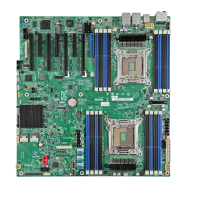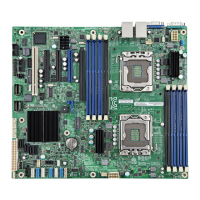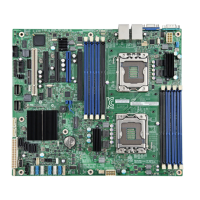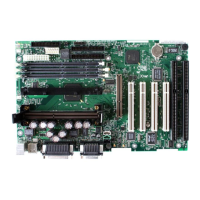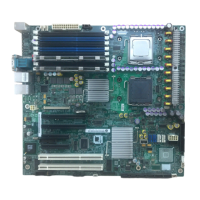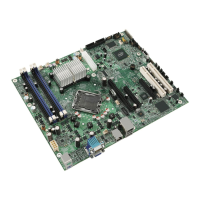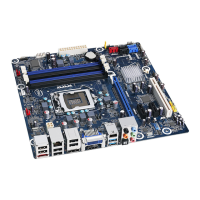
Do you have a question about the Intel S2600GL and is the answer not in the manual?
| Socket Type | LGA 2011 |
|---|---|
| CPU Socket | LGA 2011 |
| Max CPU Support | 2 |
| Chipset | Intel C602 |
| Max Memory | 512 GB |
| Number of Memory Slots | 16 |
| Expansion Slots | 7 |
| CPU Support | Intel Xeon E5-2600 series |
| Storage Interface | SATA 6Gb/s |
| RAID Support | Yes |
| Network Interface | 2 x Gigabit Ethernet |
| Power Connector | 24-pin ATX |
| Form Factor | SSI EEB 3.61 |
Defines the scope and purpose of this troubleshooting guide for Intel platforms.
Explains industry standards like IPMI and BMC for server management.
Details default values and formats for System Event Log (SEL) records.
Provides guidance on capturing and interpreting SEL logs, including data formats.
Cross-references BMC-owned sensors, their details, and next steps for troubleshooting.
Lists sensors owned by BIOS POST, including their details and troubleshooting steps.
Lists Microsoft OS-owned events and their corresponding details and next steps.
Cross-references sensors managed by BIOS SMI Handler with troubleshooting guidance.
Details sensors managed by Node Manager/ME firmware with associated next steps.
Details threshold-based voltage sensors, their characteristics, and event triggers.
Explains the Voltage Regulator Watchdog Timer sensor and its typical characteristics.
Monitors the power state of the system and logs state changes in the SEL.
Covers power supply status, power input, current output, and temperature sensors.
Details fan sensors: speed, presence, and redundancy, and their characteristics.
Describes various temperature sensors like threshold-based, thermal margin, and discrete.
Monitors status information for each processor slot and its event states.
Reports when the Catastrophic Error signal (CATERR#) is asserted, indicating hardware issues.
Detects and reports if a CPU is not installed or is in the incorrect socket.
Covers sensors related to the Intel Quick Path Interconnect (QPI) bus for processor communication.
Logs memory RAS configuration status and errors after AC power-on.
Records changes in memory RAS Mode, such as Mirroring or Lockstep modes.
Monitors memory mirroring mode and logs events when redundancy is lost.
Tracks memory sparing mode and logs events when redundancy is lost due to errors.
Details memory data errors (correctable/uncorrectable) and address parity errors.
Details on PCI Express errors, including fatal, correctable, and legacy types for troubleshooting.
Covers BIOS events occurring during POST or sleep state transitions.
Logs POST errors and system firmware progress, providing information on potential issues.
Monitors chassis intrusion and LAN leash status for physical security.
Logs events from diagnostic interrupt button presses or IPMI Chassis Control commands.
Logs front panel power and reset button presses for informational purposes.
Checks OS responsiveness using an IPMI watchdog timer and logs expiry actions.
Handles system management interrupts; logs timeout events which freeze the system.
Logs when the System Event Log (SEL) is cleared, either manually or during manufacturing.
Logs events where BMC takes action based on Platform Event Filter (PEF) configuration.
Reports BMC resets due to BMC Watchdog feature actions or BMC CPU resets.
Tracks BMC firmware health and reports sensor failures, indicating hardware access layer errors.
Generates SEL events related to embedded firmware updates for BMC, BIOS, and ME.
Indicates whether add-in modules/boards are installed in dedicated server board slots.
Provides limited manageability for Intel Xeon Phi Coprocessor adapters, including thermal and status sensors.
Measures ambient temperature using a thermal sensor on the Hot-Swap Backplane.
Monitors Hard Disk Drive status, including drive presence and faults.
Indicates the health of the Hot-Swap Controller (HSC), reporting offline or degraded states.
Reports health information for ME firmware, including upgrade and application errors.
Logs events when the maintained policy power limit is exceeded over the correction time limit.
Provides runtime error indications about Intel Intelligent Power Node Manager's health.
Indicates changes in Node Manager's operational capabilities like policy interface and monitoring.
Logs events when maintained policy power limits are exceeded, affecting power management.
Logs boot-up and OEM events when the system starts in Microsoft Windows OS.
Records OS stop/shutdown events, shutdown reason codes, and comments during system shutdown.
Logs bug check (blue screen) events, including OS stop/shutdown and OEM codes for failure analysis.
Details Linux kernel panic events captured in the system event log.

